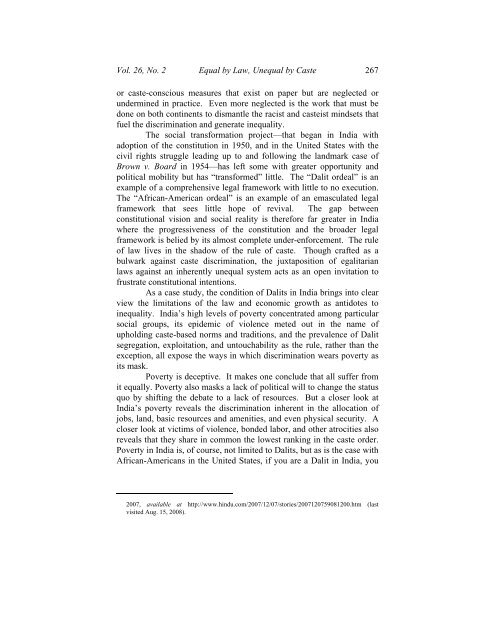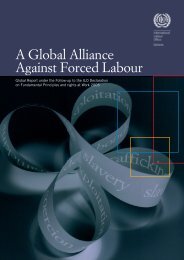266 Wisconsin <strong>International</strong> Law JournalIn both countries, <strong>caste</strong>- or race-based stigma has not beenerased <strong>by</strong> upward class mobility. 49 Even for the minority of <strong>Dalit</strong>s whohave managed to defy their religiously proscribed economic lot, socialoppression has not fallen away. As poignantly noted <strong>by</strong> a <strong>Dalit</strong> surgeon,It is India’s most shameful paradox—this country has made almostunimaginable progress in nearly every sphere of human life, but theone thing unchanged is the condition of its dalits and backwardcommunities. I am a microsurgeon specialising in hand and spinalreconstruction, and am [a Member of Legislative Assembly] fromBihar, but I still remain very much a dalit—a dhobi, to be precise—open to routine humiliation from the upper <strong>caste</strong>s. 50The inter-category diversity among <strong>Dalit</strong>s that comes about as aresult of the creation of a new <strong>Dalit</strong> middle class is cited not as thesuccess of affirmative action that it represents, but as the reason to nowdefeat the affirmative action project. Class operates in both countries asa displacement strategy. And in both countries the criminal justicesystem and its application to particular groups suffers from the twinmalaise of over- and under-enforcement. <strong>Dalit</strong>s are routinely rounded upfor crimes committed in their vicinity, 51 yet summarily ignored whenthey themselves are the victims of abuse. 52Like the United States, India’s social transformation project isstunted <strong>by</strong> its increasing dependency on courts as a source of redress; itsrecourse to the legislature and courts is seen as the dominant avenue forsocial reform. The disproportionate focus on proportionalrepresentation—or policies that aim to increase the representation ofmarginalized groups in the legislature, institutes of higher education, andnow the private sector—is where this conversation gets debated anddefeated. 53 Left out of consideration is the broad range of possible race-4950515253As Derrick Bell argues in relation to racism in the United States, “[w]hatever our status, we arefeared because we might be one of ‘them.’” Derrick Bell, The Racism Is Permanent Thesis:Courageous Revelation or Unconscious Denial of Racial Genocide, 22 CAPITAL U. L. REV. 571,581 (1993).Ramsunder Ram Kanauija, Surgeon Second, Dhobi First, TEHELKA, Feb. 3, 2007, available athttp://www.tehelka.com/story_main26.asp?filename=Cr020307Shadow_lines.asp (last visitedAug. 15, 2008).HIDDEN APARTHEID, supra note 5, at 28.Id. at 33-34.Journalist and social commentator P. Sainath notes: “In the media, any debate on <strong>Dalit</strong> rights isabout reservation, and not about water, health, sanitation or land rights. In the minds of themedia audience, we have created a stereotype that <strong>Dalit</strong> is <strong>equal</strong> to reservation, which is takenout of the context of all these other deprivations.” He adds that the growing trend of using thelanguage of <strong>equal</strong>ity and meritocracy to oppose reservations represents a “‘repackaging’ of<strong>caste</strong>ism and <strong>caste</strong> stereotypes.” Trend of repackaging <strong>caste</strong>ism growing, THE HINDU, Dec. 7,
Vol. 26, No. 2 Equal <strong>by</strong> Law, Un<strong>equal</strong> <strong>by</strong> Caste 267or <strong>caste</strong>-conscious measures that exist on paper but are neglected orundermined in practice. Even more neglected is the work that must bedone on both continents to dismantle the racist and <strong>caste</strong>ist mindsets thatfuel the discrimination and generate in<strong>equal</strong>ity.The social transformation project—that began in India withadoption of the constitution in 1950, and in the United States with thecivil rights struggle leading up to and following the landmark case ofBrown v. Board in 1954—has left some with greater opportunity andpolitical mobility but has “transformed” little. The “<strong>Dalit</strong> ordeal” is anexample of a comprehensive legal framework with little to no execution.The “African-American ordeal” is an example of an emasculated legalframework that sees little hope of revival. The gap betweenconstitutional vision and social reality is therefore far greater in Indiawhere the progressiveness of the constitution and the broader legalframework is belied <strong>by</strong> its almost complete under-enforcement. The ruleof <strong>law</strong> lives in the shadow of the rule of <strong>caste</strong>. Though crafted as abulwark against <strong>caste</strong> discrimination, the juxtaposition of egalitarian<strong>law</strong>s against an inherently un<strong>equal</strong> system acts as an open invitation tofrustrate constitutional intentions.As a case study, the condition of <strong>Dalit</strong>s in India brings into clearview the limitations of the <strong>law</strong> and economic growth as antidotes toin<strong>equal</strong>ity. India’s high levels of poverty concentrated among particularsocial groups, its epidemic of violence meted out in the name ofupholding <strong>caste</strong>-based norms and traditions, and the prevalence of <strong>Dalit</strong>segregation, exploitation, and untouchability as the rule, rather than theexception, all expose the ways in which discrimination wears poverty asits mask.Poverty is deceptive. It makes one conclude that all suffer fromit <strong>equal</strong>ly. Poverty also masks a lack of political will to change the statusquo <strong>by</strong> shifting the debate to a lack of resources. But a closer look atIndia’s poverty reveals the discrimination inherent in the allocation ofjobs, land, basic resources and amenities, and even physical security. Acloser look at victims of violence, bonded labor, and other atrocities alsoreveals that they share in common the lowest ranking in the <strong>caste</strong> order.Poverty in India is, of course, not limited to <strong>Dalit</strong>s, but as is the case withAfrican-Americans in the United States, if you are a <strong>Dalit</strong> in India, you2007, available at http://www.hindu.com/2007/12/07/stories/2007120759081200.htm (lastvisited Aug. 15, 2008).
- Page 1 and 2: EQUAL BY LAW, UNEQUAL BY CASTE: THE
- Page 3 and 4: Vol. 26, No. 2 Equal by Law, Unequa
- Page 5 and 6: Vol. 26, No. 2 Equal by Law, Unequa
- Page 7 and 8: Vol. 26, No. 2 Equal by Law, Unequa
- Page 9 and 10: Vol. 26, No. 2 Equal by Law, Unequa
- Page 11: Vol. 26, No. 2 Equal by Law, Unequa
- Page 15 and 16: Vol. 26, No. 2 Equal by Law, Unequa
- Page 17 and 18: Vol. 26, No. 2 Equal by Law, Unequa
- Page 19 and 20: Vol. 26, No. 2 Equal by Law, Unequa
- Page 21 and 22: Vol. 26, No. 2 Equal by Law, Unequa
- Page 23 and 24: Vol. 26, No. 2 Equal by Law, Unequa
- Page 25 and 26: Vol. 26, No. 2 Equal by Law, Unequa
- Page 27 and 28: Vol. 26, No. 2 Equal by Law, Unequa
- Page 29 and 30: Vol. 26, No. 2 Equal by Law, Unequa
- Page 31 and 32: Vol. 26, No. 2 Equal by Law, Unequa
- Page 33 and 34: Vol. 26, No. 2 Equal by Law, Unequa
- Page 35 and 36: Vol. 26, No. 2 Equal by Law, Unequa
- Page 37 and 38: Vol. 26, No. 2 Equal by Law, Unequa
- Page 39 and 40: Vol. 26, No. 2 Equal by Law, Unequa
- Page 41 and 42: Vol. 26, No. 2 Equal by Law, Unequa
- Page 43 and 44: Vol. 26, No. 2 Equal by Law, Unequa
- Page 45 and 46: Vol. 26, No. 2 Equal by Law, Unequa
- Page 47 and 48: Vol. 26, No. 2 Equal by Law, Unequa
- Page 49 and 50: Vol. 26, No. 2 Equal by Law, Unequa
- Page 51 and 52: Vol. 26, No. 2 Equal by Law, Unequa
- Page 53 and 54: Vol. 26, No. 2 Equal by Law, Unequa
- Page 55: Vol. 26, No. 2 Equal by Law, Unequa
- Page 58 and 59: 312 Wisconsin International Law Jou
- Page 60 and 61: 314 Wisconsin International Law Jou
- Page 62 and 63:
316 Wisconsin International Law Jou
- Page 64 and 65:
318 Wisconsin International Law Jou
- Page 66 and 67:
320 Wisconsin International Law Jou
- Page 68 and 69:
322 Wisconsin International Law Jou
- Page 70 and 71:
324 Wisconsin International Law Jou
- Page 72 and 73:
326 Wisconsin International Law Jou
- Page 74 and 75:
328 Wisconsin International Law Jou
- Page 76 and 77:
330 Wisconsin International Law Jou
- Page 78 and 79:
332 Wisconsin International Law Jou
- Page 80 and 81:
334 Wisconsin International Law Jou
- Page 82 and 83:
336 Wisconsin International Law Jou
- Page 84 and 85:
338 Wisconsin International Law Jou
- Page 86 and 87:
340 Wisconsin International Law Jou
- Page 88 and 89:
342 Wisconsin International Law Jou
















